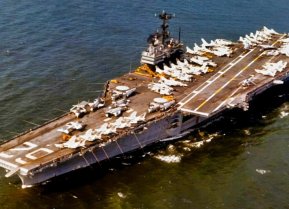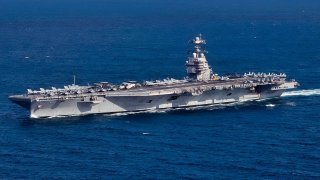USS John F. Kennedy: This New Aircraft Carrier Might Be the Navy's Best Ever
The Ford-class, including the under-construction USS John F. Kennedy, will be the world’s premier aircraft carrier.
Meet the new USS John F. Kennedy Aircraft Carrier: The U.S. Navy has done well for itself politically. For a while, being a former Navy sailor almost seemed like a prerequisite for serving as president. Lyndon B. Johnson, Richard M. Nixon, Jimmy Carter, and George H. W. Bush all served in the U.S. Navy before eventually becoming President. And that’s not all. Gerald R. Ford served in the Navy, which is why his name adorns the most cutting-edge and expensive boat in the sea, the Gerald R. Ford-class aircraft carrier.
Still, neither Johnson, Nixon, Carter, Bush, nor Ford is the U.S. Navy’s most prominent sailor turned president. That distinction belongs to John F. Kennedy – who in death has become a beatified martyr, and who in life had become a beatified war hero for his service upon PT-109. Long story short: when a Japanese destroyer sank PT-109, Kennedy helped save his crew. Kennedy sustained back injuries that would plague him for the rest of his life.
Since Kennedy’s assassination in 1963, the U.S. Navy has played an active role in commemorating its former lieutenant, naming three separate ships after Kennedy – the most remarkable of which is the soon-to-be-commissioned CVN-79, the second Gerald R. Ford-class carrier, the USS John F. Kennedy.
USS John F. Kennedy: The Most Expensive Warship Ever?
The Gerald R. Ford-class aircraft carrier is the most expensive warship ever built. Each boat costs $13 billion – more than the entire GDP of many countries. Why such a massive investment? The aircraft carrier is a foundational element of U.S. foreign policy. As the backbone of a liberal hegemonic order, the U.S. is actively engaged in various locations around the globe, simultaneously. Accordingly, U.S. foreign policy calls for the rapid projection of power.
To project power, the U.S. relies on a vast network of several hundred overseas military bases. But military bases are fixed and inflexible. For mobile power projection, the U.S. relies most especially on the aircraft carrier. A floating city, running on virtually unlimited nuclear power, that services a floating airfield, capable of launching the carrier’s hundred or so aircraft from roughly anywhere in the world.
The Ford-class, including the under-construction USS John F. Kennedy, will be the world’s premier aircraft carrier. Frankly, the U.S. is uncontested with respect to aircraft carrier technology; the U.S. legacy fleets, like the Enterprise- and the Nimitz-class, which the Ford is replacing, are more advanced than any carrier in any other countries’ arsenal. But the Ford-class is forward-looking, designed to remain superior well into the future, even as China works to expand its naval capabilities and challenge U.S. hegemony.
To stay ahead, the U.S. is willing to make a 12-figure investment in the Ford program. While each boat costs $13 billion, the program itself has already cost a staggering $120 billion.
Technological Advancements
What does $120 billion get you exactly? Many U.S. taxpayers ask that question. In the case of the Ford-class, $120 billion gets you a ship with the highest Sortie Generation Rate (SGR) in the Navy. While most civilians have never heard of an SGR, it’s a vital metric in gauging the effectiveness of an aircraft carrier to fulfill the essence of its existence: launch aircraft.
As an aircraft carrier exists to project airpower, the rate at which an aircraft carrier can launch aircraft is crucial in determining the worthiness of the aircraft carrier. The Ford is expected to be very effective at launching aircraft. In fact, the Ford, and the USS John F. Kennedy, are expected to have a 33 percent higher SGR than the Nimitz-class. The Ford is projected to reach 160 sorties per day – with the capacity to hit 270 in a wartime crunch. To achieve an SGR so much higher than the Nimitz, the Ford will rely on novel technologies: the Electromagnetic Aircraft Launch System (EMALS) and the Advanced Arresting Gear System (AAG). The EMALS is especially impressive.
The EMALS offers an improvement over the steam piston catapult featured on Nimitz and Enterprise carriers. The EMALS relies on a linear induction motor, which uses electric currents to create a magnetic field. The magnetic field is capable of moving an aircraft along a track, down the carrier’s deck, before finally launching the aircraft with enough speed to maintain flight. The EMALS is expected to accelerate aircraft in a smoother manner than the steam piston catapults – which will be good for the aircraft in the long term, requiring less maintenance. The EMALS itself is expected to require less maintenance (and won’t require freshwater/desalination like the steam piston catapults).
Yet, the EMALS’ most important benefit will be aiding in an SGR reduction. How? One, the EMALS recharges faster than steam catapults, so less time will be required between launches. Two, the EMALS is more adjustable than the steam catapults, meaning the EMALS can be adjusted with closer specificity, meaning that the EMALS can launch more kinds of aircraft.
The USS John F. Kennedy, featuring the EMALS system and high SGR, is expected to be commissioned in 2025.
About the Author
Harrison Kass is a prolific defense writer with over 1,000 published articles. An attorney, pilot, guitarist, and minor pro hockey player, Harrison joined the US Air Force as a Pilot Trainee but was medically discharged. Harrison holds a BA from Lake Forest College, a JD from the University of Oregon, and an MA from New York University. Harrison listens to Dokken.
All images are Creative Commons.


